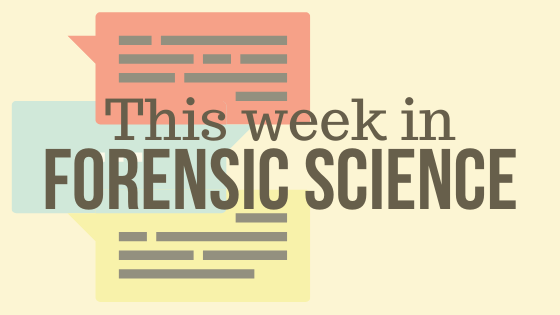No one has hours to scour the papers to keep up with the latest news, so we’ve curated the top news stories in the field of Forensic Science for this week. Here’s what you need to know to get out the door!
FBI Approves Thermo Fisher Scientific’s Rapid DNA Solution for National DNA Index System (Forensic – 9/11/2020)
The U.S. Federal Bureau of Investigation (FBI) has approved Thermo Fisher Scientific’s Applied Biosystems RapidHIT ID System for use by accredited forensic DNA laboratories to process DNA reference samples and search resulting profiles against the U.S. National DNA Index System (NDIS) CODIS database without manual interpretation and review.
Latent Fingerprint Specialist Breaks Open 20-Year-Old Sexual Assault Case (Forensic – 9/11/2020)
- DNA, fingerprints, a silver gun and a bizarre Facebook tirade led them to a man suspected of sexually attacking a woman nearly 20 years ago, Tampa police said.
Genetic Genealogy Think Tank Proposes a Streamlined Approach for the Future (Forensic – 9/14/2020)
- Announced this morning during a virtual presentation at the 31st annual ISHI conference, genealogist Colleen Fitzpatrick and like-minded professionals have teamed to create the Operational Casework Implementation of Investigative Genetic Genealogy, or OCIG for short. OCIG seeks to create a streamlined approach to the use of IGG in law enforcement, essentially creating a framework for the popular technique to more effectively find its place in the forensic workflow.
Authorities Find Bones in Illinois After Serial Killer Reveals Location to Podcast Host (Forensic – 9/14/2020)
The discovery of the bones came after Colvin was interviewed by criminal profiler Phil Chalmers during Chalmers’ podcast, “Where the Bodies are Buried.” Colvin told Chalmers that in 2004 or 2005 he met a woman at the Flying J Travel Center along Interstate 80 outside LaSalle. He said he killed, then drove to a truck wash in Peru, where he dumped her body.
Utah Clears Rape Kit Backlog, Leaders Expect Further Reform (Forensic – 9/14/2020)
Valentine cautioned that residents should not consider it the end of the backlog but instead the “beginning of our continued pursuit for justice and eradicating sexual violence.”
More than 11,000 rape kits statewide have been tested since 2015, according to data from the crime lab. It has led to 5,025 forensic DNA profiles being entered into a national database and about 2,000 suspects being identified.
How a Public DNA Ancestry Website Helped Solve a 40-Year-Old Cold Case (The Science Times – 9/14/2020)
- In the course of investigation, more than 125 people underwent DNA swabbing to be compared to the sample found in the crime scene. After another 11 years, in 2017, a private company specializing in DNA phenotypes were tasked with drawing physical clues about the killer based on DNA samples, revealing different features from the composite sketch released in the 80s. The same DNA phenotyping company used their data and entered it into GEDmatch – an online service that compares DNA samples from files provided by different testing companies.
Extracting Ancient DNA of Long-Extinct Plants and Animals From Soil (SciTech Daily – 9/14/2020)
- Researchers at McMaster University have developed a new technique to tease ancient DNA from soil, pulling the genomes of hundreds of animals and thousands of plants — many of them long extinct — from less than a gram of sediment.
FBI Pilots Rapid DNA at Booking Stations, ID’s Challenges for Crime Scenes (Forensic – 9/15/2020)
- Since the passing of the Rapid DNA Act in 2017, the FBI has been working toward ensuring the technology reaches its highest potential. In a virtual presentation during the 31st annual ISHI conference, Douglas Hares, the Rapid DNA Implementation Program Advisor for the FBI, revealed the federal agency has taken a significant step forward—they conducted booking station pilot programs in four states and turned the lessons learned into a Standards and Procedure document approved by the FBI director last month.
DNA Identified a Man’s Remains in Butler County. But How Did He Die? (Journal-News – 9/15/2020)
The remains of a man found in the Great Miami River north of Hamilton in 1997 have been identified using DNA.
The Butler County Coroner’s Office and the DNA Doe Project announced the identification of Larry Joe Porter on Monday.
Hot Desert, Cold Cases: Brianna Wells (Forensic – 9/16/2020)
- This summer, the Phoenix Police Department has launched a new initiative to bring attention to cold case homicides. “Hot Desert, Cold Cases” will be a series of videos and other posts on the department’s social media profiles, highlighting cold cases. In addition, Silent Witness is upping the reward for information leading to the arrest and/or indictment of the suspect/s of the crime. The reward will be $5,000 for the first four cold cases.
NYPD, Private Forensic Lab will Create ‘Virtual Mugshots’ from DNA Samples – But Critics Challenge Technology (Daily News – 9/16/2020)
- Using DNA samples gathered at crime scenes by police investigators, scientists and forensic artists at Parabon Nanolabs will draw up digital sketches of potential suspects based on their genetic data.
‘Viking’ was a Job Description, Not a Matter of Heredity, Massive Ancient DNA Study Shows (Science – 9/16/2020)
- The new data come from a massive effort to sequence the DNA of Vikings across Europe. The results, published today in Nature, trace how the Vikings radiated across Europe from their Scandinavian homeland, and how people with roots elsewhere also took up Viking ways.
Record-Setting 2200 Forensic DNA Experts Attend Promega-Hosted Virtual Symposium (News Medical Life Sciences – 9/17/2020)
- ISHI is the largest and longest-running meeting focusing entirely on forensic DNA. Promega, a manufacturer of products for DNA-based human identification, began the annual meeting 31 years ago to facilitate collaboration and innovation. This year’s virtual platform, offering a mixture of live and on-demand presentations, is enabling a record-setting 2200 people to attend, and registration is still open.
WOULD YOU LIKE TO SEE MORE ARTICLES LIKE THIS? SUBSCRIBE TO THE ISHI BLOG BELOW!
SUBSCRIBE NOW!


